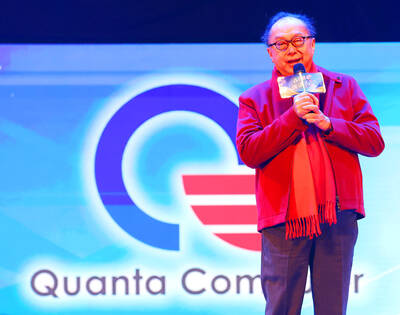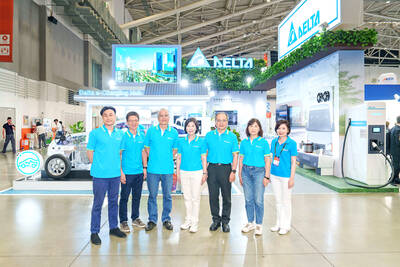Qualcomm Inc yesterday unveiled its latest quad-core chips for entry-level smartphones in China in an effort to fend off growing competition from MediaTek Inc (聯發科).
Qualcomm Technologies Inc, a fully-owned subsidiary of Qualcomm, is set to release Qualcomm Reference Design (QRD) versions of chips, dubbed 8x10 and 8x12, based on its latest Snapdragon 200 family of processors, the company said in a statement.
The new dual-core and quad-core processors will be made on advanced 28-nanometer (nm) technology, an upgrade from 45-nanometer technology. The chips support HSPA+ and TDSCDMA technologies, the latter being mostly used in China.
“With the expanded line of Snapdragon 200 processors, Qualcomm Technologies is building on its dual and quad-core processor portfolio for entry-level smartphones and tablets,” said Jeff Lorbeck, the company’s senior vice president and chief operating officer in China.
The launch followed Qualcomm’s introduction of a QRD version of a quad-core chip for the mass smartphone market six months ago in Shenzhen, China.
Mobile phones equipped with quad-core chips generally transmit data faster and are power efficient than handsets with dual-core chips.
There have been more than 250 public QRD-based product launches to date, an increase of 80 models from six months ago.
MediaTek, the biggest handset chip designer in Taiwan, said last month that it aims to expand its Chinese market share from 30 percent to 40 percent this year, largely as a result of increasing demand in China for quad-core chips.
The company is scheduled to ship its second-generation quad-core chip, named MT6582, next quarter, primarily to Chinese customers.
MediaTek said demand for its first quad-core MT6589 chips have been strong since its launch in the first quarter of this year.
It said it expects the new chip to account for 20 percent of its smartphone shipments this quarter, up from a 10 percent share last quarter. That share is expected to reach 35 percent for the whole year.
The company is also planning to ship dual-core chips this quarter that are made on cost-efficient and power-efficient 28nm technology rather than on 45nm technology.
Beijing Tianyu Communication Equipment Co Ltd (北京天宇朗通), a Chinese customer of Qualcomm’s, yesterday unveiled its latest fourth-generation (4G) smartphone during Qualcomm’s fourth QRD summit in Shenzhen.
The smartphone has been used by China Mobile Ltd (中國移動) for a 4G trial, paving the way for a commercial launch by the end of this year when the Chinese authorities are scheduled to release 4G spectrum licenses.
China Mobile expects to offer about 120 long-term evolution (LTE) devices this year.
MeidaTek also plans to ship its first time-division long-term evolution (TD-LTE) chip by the end of this year.

Quanta Computer Inc (廣達) chairman Barry Lam (林百里) is expected to share his views about the artificial intelligence (AI) industry’s prospects during his speech at the company’s 37th anniversary ceremony, as AI servers have become a new growth engine for the equipment manufacturing service provider. Lam’s speech is much anticipated, as Quanta has risen as one of the world’s major AI server suppliers. The company reported a 30 percent year-on-year growth in consolidated revenue to NT$1.41 trillion (US$43.35 billion) last year, thanks to fast-growing demand for servers, especially those with AI capabilities. The company told investors in November last year that

Intel Corp has named Tasha Chuang (莊蓓瑜) to lead Intel Taiwan in a bid to reinforce relations between the company and its Taiwanese partners. The appointment of Chuang as general manager for Intel Taiwan takes effect on Thursday, the firm said in a statement yesterday. Chuang is to lead her team in Taiwan to pursue product development and sales growth in an effort to reinforce the company’s ties with its partners and clients, Intel said. Chuang was previously in charge of managing Intel’s ties with leading Taiwanese PC brand Asustek Computer Inc (華碩), which included helping Asustek strengthen its global businesses, the company

Taiwanese suppliers to Taiwan Semiconductor Manufacturing Co. (TSMC, 台積電) are expected to follow the contract chipmaker’s step to invest in the US, but their relocation may be seven to eight years away, Minister of Economic Affairs J.W. Kuo (郭智輝) said yesterday. When asked by opposition Chinese Nationalist Party (KMT) Legislator Niu Hsu-ting (牛煦庭) in the legislature about growing concerns that TSMC’s huge investments in the US will prompt its suppliers to follow suit, Kuo said based on the chipmaker’s current limited production volume, it is unlikely to lead its supply chain to go there for now. “Unless TSMC completes its planned six

Power supply and electronic components maker Delta Electronics Inc (台達電) yesterday said it plans to ship its new 1 megawatt charging systems for electric trucks and buses in the first half of next year at the earliest. The new charging piles, which deliver up to 1 megawatt of charging power, are designed for heavy-duty electric vehicles, and support a maximum current of 1,500 amperes and output of 1,250 volts, Delta said in a news release. “If everything goes smoothly, we could begin shipping those new charging systems as early as in the first half of next year,” a company official said. The new